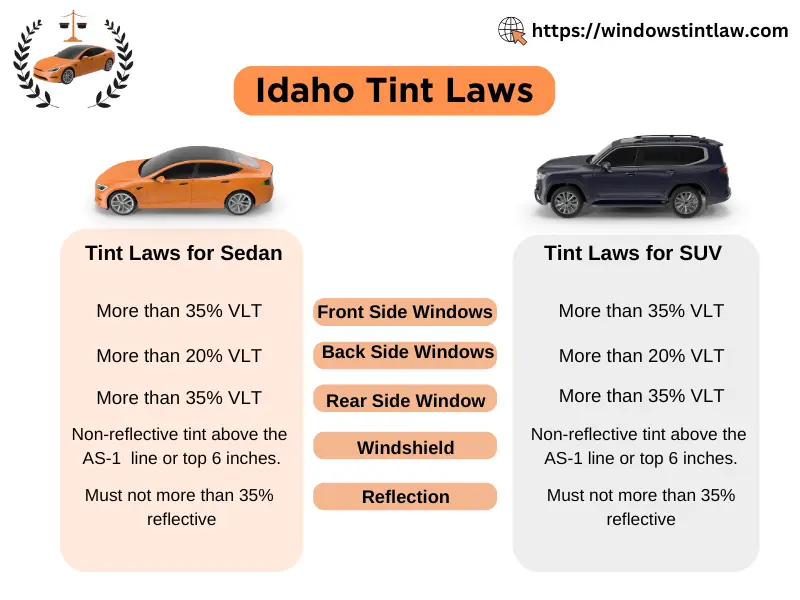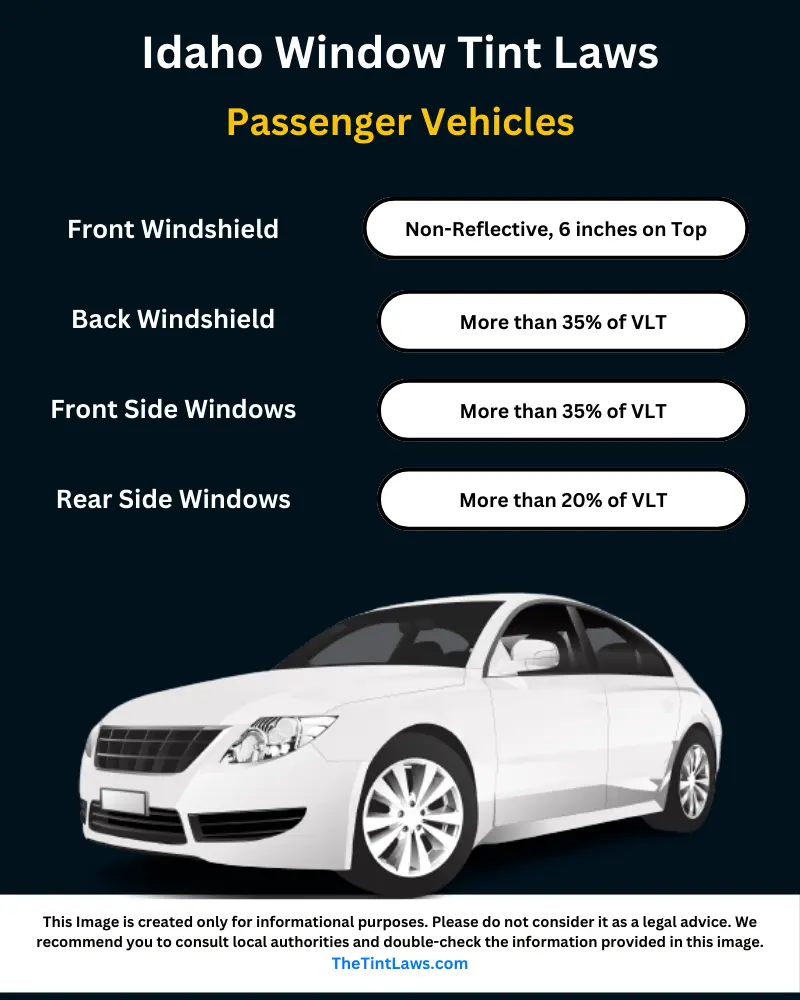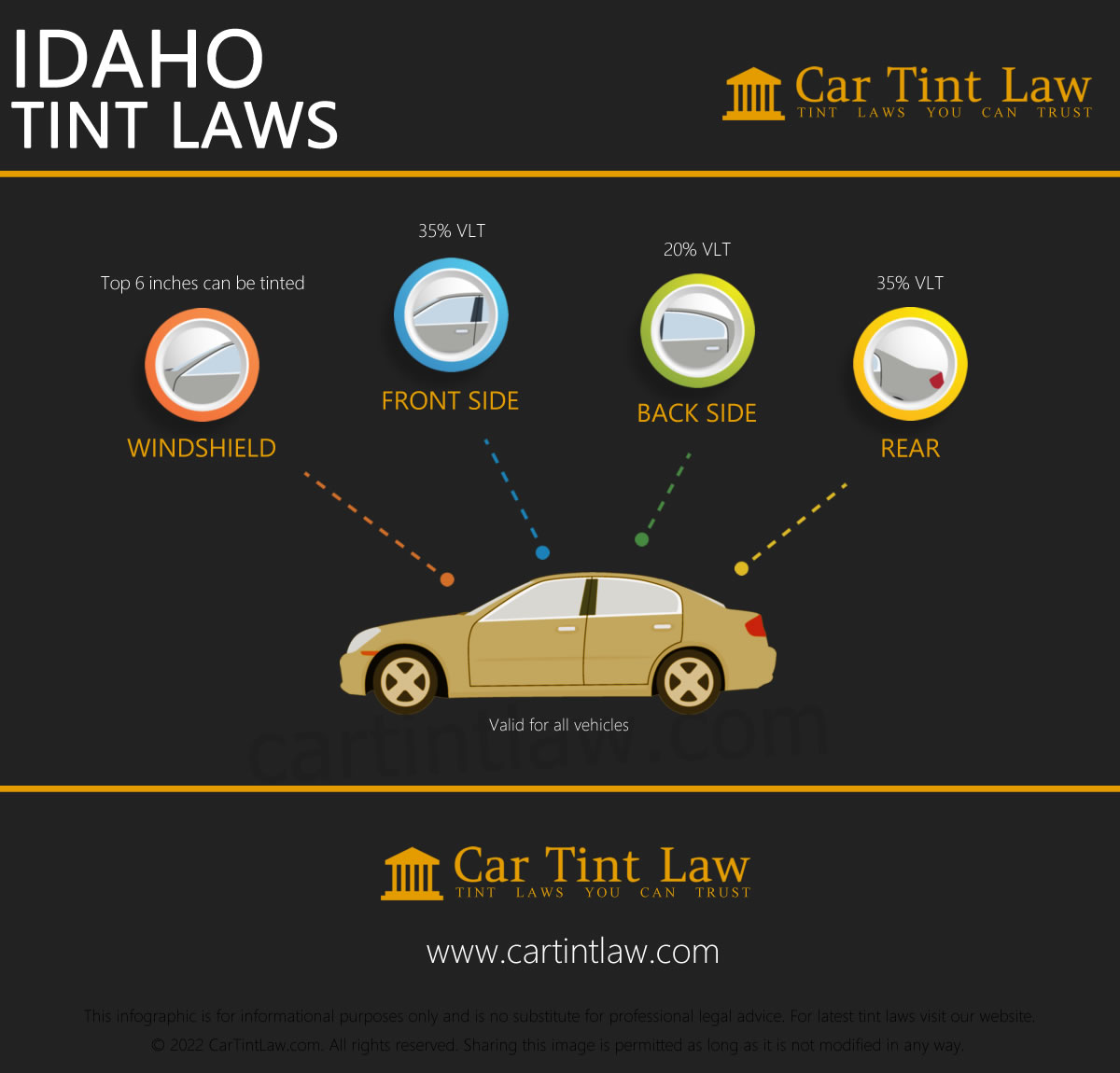Have you ever wondered about the rules surrounding window tinting in Idaho? Whether you’re considering a sleek look for your vehicle or just trying to keep the sun at bay, understanding Idaho’s tint law is crucial.
You don’t want to end up with a ticket or have to peel off your carefully applied film. You’ll discover everything you need to know about Idaho tint law. We’ll break down the legal limits, exemptions, and the reasons behind these regulations.
You’ll feel more confident making decisions about your car’s windows, knowing you’re on the right side of the law. Let’s dive into the specifics and ensure your ride is both stylish and compliant!

Credit: windowstintlaw.com
Overview Of Tint Laws In Idaho
Imagine cruising through the picturesque landscapes of Idaho, where the expansive blue skies and rugged mountains create a mesmerizing backdrop for your journey. As you enjoy the scenic drive, have you ever wondered why the tint on your car windows is regulated? Understanding the tint laws in Idaho is essential for every driver, ensuring that your vehicle complies with legal standards while enhancing your driving experience.
Purpose Of Tint Regulations
The primary aim of tint regulations is safety. By controlling the level of window tinting, these laws ensure visibility is maintained for drivers and law enforcement officers. Proper visibility is crucial, especially when driving through Idaho’s diverse terrains, from urban streets to rural roads.
Consider a scenario where you’re driving at night with overly dark windows. It could hinder your ability to spot pedestrians or wildlife crossing the road. Tint laws help mitigate such risks. They also serve to protect law enforcement personnel during traffic stops, allowing them to see inside the vehicle.
Another purpose of these regulations is to balance privacy and security. While you might want to shield your car’s interior from prying eyes, excessively dark tints can raise concerns for public safety. The laws strike a balance, providing enough privacy without compromising security.
Historical Context
Understanding the historical background of tint laws can offer insights into why they exist today. Initially, tinting was a luxury, associated with high-end vehicles. As tinting technology evolved, it became accessible to all, prompting the need for regulation.
In the past, there were fewer restrictions, which led to inconsistent application of tinting. Some vehicles had excessively dark tints, posing safety issues. Over time, as awareness grew about the potential hazards, Idaho implemented specific regulations to standardize tint levels.
These laws have evolved to reflect technological advancements and societal needs. As you drive through Idaho, knowing these regulations can help you appreciate the balance between innovation and safety. How do you think tint laws affect your driving experience?
The next time you’re adjusting your car’s window tint, consider these laws as a guide to enhance your journey across Idaho’s beautiful landscapes. Compliance not only keeps you within legal boundaries but also ensures a safer driving environment for everyone.
Permissible Tint Levels
Understanding permissible tint levels in Idaho can save you from unnecessary fines and ensure you enjoy a comfortable driving experience. Tinting your car windows is not just about aesthetics; it’s also about safety and legality. Knowing the rules means you can customize your ride without any legal headaches. So, what exactly are the permissible tint levels in Idaho?
Front Windows
Idaho law allows for a limited amount of tint on your front windows. You can tint up to 35% of light reflection, which means you still get privacy without compromising visibility. Ever had that moment when the sun hits just right and blinds you? A legal tint can help reduce glare, making your drive safer. Have you checked your tint levels lately?
Rear Windows
Good news if you prefer darker rear windows! Idaho permits more flexibility here. You can apply tinting as dark as you desire. This is particularly useful if you frequently carry cargo or enjoy additional privacy in your vehicle. Just imagine the added comfort during those long summer road trips.
Windshield Restrictions
When it comes to windshields, Idaho is quite specific. Tinting is only allowed on the top five inches of the windshield. This strip, often called the “eyebrow,” can block intense sunlight without compromising your field of vision. Ever noticed how a well-placed tint strip can make a huge difference on a sunny day? Make sure your windshield tint is both effective and compliant.
Are these tint levels new to you? Ensuring your vehicle complies with Idaho’s tint laws not only avoids fines but also enhances your driving comfort and safety. Take a moment to check your vehicle’s tint levels. It might just be the smartest move you make today.
Exceptions And Special Cases
Idaho’s tint law includes exceptions for certain medical conditions, allowing special permits for darker window tints. Vehicles used by law enforcement and emergency services may also have different tint regulations, ensuring safety and operational effectiveness. These special cases highlight flexibility within the general tinting rules.
Understanding the nuances of Idaho’s tint law can sometimes feel like navigating a complex maze. However, certain exceptions and special cases can make this journey smoother. Whether it’s for medical reasons or commercial purposes, these exceptions are worth knowing if you’re considering tinting your vehicle’s windows in Idaho. ###Medical Exemptions
Did you know that Idaho allows for medical exemptions when it comes to window tinting? If you have a medical condition that necessitates darker tints, you can apply for an exemption. To qualify, you need a prescription or a signed statement from a licensed physician. This document must specify the medical necessity for the tint, making it a straightforward process if you have genuine needs. Imagine the relief of stepping into a car where the sun’s glare is no longer a health concern. For many, this isn’t just a comfort but a necessity. If you think you may qualify, it’s worth discussing with your doctor. ###Commercial Vehicles
Do commercial vehicles have to follow the same tint laws? In Idaho, the rules are a bit different for them. Commercial vehicles often need to transport goods or passengers, which may require special considerations for window tinting. The law allows for some flexibility, but it’s crucial to understand the specific requirements for your vehicle type. If you operate a commercial vehicle, double-checking the regulations can save you from hefty fines. Understanding these nuances not only ensures compliance but also optimizes the comfort and safety of your vehicle. As you evaluate your situation, consider how these exceptions might apply to you. Are you aware of the specific needs your vehicle might have? By taking the time to understand these special cases, you can make informed decisions that suit your lifestyle and comply with the law.
Credit: thetintlaws.com
Penalties For Non-compliance
Idaho’s tint law sets specific standards for vehicle window tinting. Non-compliance can lead to serious consequences. Understanding these penalties helps maintain your vehicle’s legality and safety.
Fines And Fees
Drivers with illegal tint face fines. These fines vary by violation severity. First-time offenders pay a smaller fee. Repeat violations result in higher fines. It’s essential to check tint levels before installation. Avoid unnecessary fines by following legal tint limits.
Impact On Vehicle Registration
Illegal tint affects vehicle registration. Cars with non-compliant tint may fail inspection. Registration renewal could be denied. This results in more hassle for vehicle owners. Ensure your tint meets state standards. This keeps your registration process smooth.
Tips For Ensuring Compliance
Understanding Idaho’s tint law is crucial for car owners. Ensure your vehicle’s windows meet legal standards by checking tint percentage limits. Regularly review regulations to avoid fines.
Ensuring compliance with Idaho’s tint laws can seem daunting, but with the right approach, it becomes manageable. By understanding the specific requirements and taking proactive steps, you can avoid fines and enjoy the benefits of tinted windows. This section offers practical tips to help you stay on the right side of the law while enhancing your vehicle’s look and feel. ###Choosing The Right Tint
Before purchasing window tint, research Idaho’s legal requirements. The state law specifies visible light transmission (VLT) percentages for different windows. For instance, the front side windows must allow more light compared to the rear ones. When I was choosing tint for my car, I found that consulting with a professional helped clear up confusion. They provided a range of options that adhered to the legal standards. Consider their recommendations and ensure your choice aligns with state regulations. Ask yourself: Does the tint you’re considering meet both your aesthetic desires and legal obligations? It’s crucial to find a balance between personal preference and compliance. ###Professional Installation
While DIY projects can be appealing, professional installation often ensures the best results. Experts have the tools and experience to apply the tint evenly and correctly. This reduces the risk of bubbles and peeling, which can lead to compliance issues. I once tried installing window tint myself and ended up with uneven coverage and air bubbles. It was frustrating and ended up costing more to fix. A professional can save you time and ensure the job is done right the first time. Consider the long-term benefits of investing in professional services. You’ll likely avoid potential fines and hassle, ensuring peace of mind on the road. By following these tips, you can achieve the perfect balance of style and legality for your vehicle’s windows. How will you ensure your ride meets Idaho’s tint laws without sacrificing personal style?Recent Updates To Tint Regulations
Idaho’s tint regulations have seen recent updates. These changes aim to enhance safety and uniformity on the road. Understanding these updates is crucial for drivers and car owners in Idaho. Staying informed helps avoid unnecessary penalties. Let’s explore these recent legislative changes and their implications.
Changes In Legislation
The new tint law in Idaho addresses visibility concerns. Authorities have adjusted permissible tint levels on vehicle windows. Front side windows now have stricter standards. The rear windows enjoy more flexibility. This change aims to increase road safety and visibility. Ensuring compliance is essential for all vehicle owners.
Implications For Drivers
These updates affect drivers directly. Non-compliance can result in fines or penalties. Drivers must ensure their vehicle tint aligns with new rules. This change may require adjustments to existing window tints. Professional tint services offer guidance and solutions. It’s important to consult experts for compliance.
Understanding tint regulations helps avoid legal issues. Following these rules enhances safety for everyone on the road. By adapting to the new standards, drivers contribute to safer driving environments. This ensures peace of mind during travel.

Credit: www.cartintlaw.com
Frequently Asked Questions
What Is The Darkest Legal Tint In Idaho?
In Idaho, the legal limit for window tint is 35% VLT for front side windows. Rear windows can be tinted to any darkness. Ensure compliance with state laws to avoid penalties.
In What State Is 20% Tint Legal?
20% tint legality varies by state. States like California and New York have strict tint laws. In Texas, 20% tint is legal on rear windows. Always check local regulations for accurate information.
Can You Still See Through 20% Tint?
Yes, you can see through 20% tint. It allows 20% of light inside, providing moderate visibility. This tint offers privacy while maintaining a clear view from inside. Many use it for enhanced privacy without compromising visibility. It’s popular for vehicles and buildings seeking a balance between light and privacy.
How Dark Is 35% Tint?
A 35% tint allows 35% of light to pass through, offering moderate privacy and glare reduction. It’s darker than factory glass but not too dark, making it popular for balancing visibility and style. Ideal for those seeking a sleek look while maintaining decent interior visibility.
Conclusion
Understanding Idaho tint laws helps you avoid legal issues. Always check regulations before tinting your vehicle. These laws ensure safety on the roads. They also protect law enforcement officers. Knowing the rules can save you from fines. Keep your tint within legal limits.
This way, you enjoy privacy without breaking the law. Stay informed and drive safely in Idaho. Remember, following the law benefits everyone. Enjoy your ride with peace of mind.
